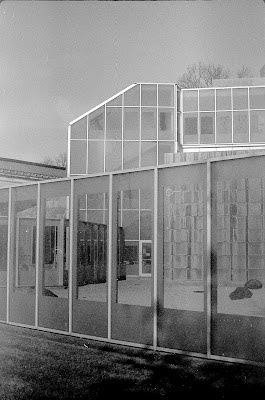Some questions I hear from aspiring photographers are: "What should I photograph?" "I don't know what to shoot, what should I do?" and "How is a snap shot different from what somebody who's famous shot?"
I think I can answer all three of those questions with one sentence -- "work a scene." What do I mean by that? Well, working a scene is something a good photographer does almost without thinking about it, but in reality, it means setting up a series of shots at a particular place to get a range of images. Taken in their entirety, the shots may provide a lot of information about the scene, but each individual image provides a singular interpretation of the scene. In fact, each image could be shot so differently that anyone seeing a series of prints later on, may not even know they are from the same place and time. Working a scene means getting a number of images from a place, and each image may bear a serial relationship to the other taken before and after, or not. But it's not a single photo of something that "looked cool." Thanks to the digital cameras that we have today, one can "work a scene" almost to death, experimenting with different effects, lenses, saturation, etc., and see the results immediately on the LCD screen. That's not a bad thing, as I think one benefit of digital photography is that it allows for exploration with immediate feedback as to what's working. You can work a scene with film, too. If you are serious about photography, working a scene is done almost unconsciously. However you photograph, no matter with film or digital, it pays to explore a scene and sometimes you will end up with images that you had not expected to take.
This morning, I anticipated that we would have some hoarfrost, so I grabbed my camera backpack with my Nikon D90 and lenses, and headed out to my vehicle (I always keep my tripod on the rear floor in my Escape), and drove off to Buhr Park. It's not far from my house, and I got there barely ahead of the sunrise. I decided to use just the 85mm 1.8 AF-D Nikkor with the extra-long lens hood, as I wanted to shoot wide-open for some shots. I have photographed the grove of apple trees in Buhr Park numerous times -- usually in fog, so I wanted some higher contrast scenes this morning and with the frost on the grass and the dark trees, I knew I would have some good opportunities for that(we have barely had any snow this winter!).
First of all, it's difficult to shoot into the sun, and you will get flare spots on your lens if you do. However, with a scene so obviously monochromatic, the colorful flare spots gave the image an entirely different look. I suspect that the 85mm 1.8 Nikkor is more flare-prone, too.

Shooting with the sun to the side and incorporating shadows from the raking light gives an altogether different interpretation of the scene. I also changed the image in PP to monochrome.

Opening up the lens to f/1.8 will give an image the appearance of more depth - while shooting at f/16 will give more depth-of-field, it does not necessarily equal the appearance of greater depth. A narrow band of focus does that.

Stopping down a bit to f/3.2, I wanted to use the sunlit side of the trees and the frosted grass. Just enough blur of the trees in the far background make the foreground pop more.

Lastly, a little PP work to give the scene a more Holga-like appearance.

It's obvious by now that all of these images are from the same place, but each of them has a differently quality and interpretation. That's working a scene (and working the brain). You will improve your photography by shooting a lot -- that's the only way to do so.









